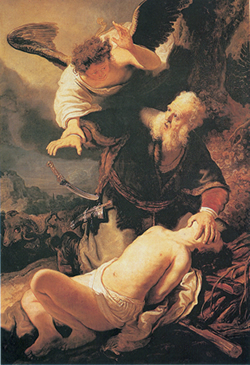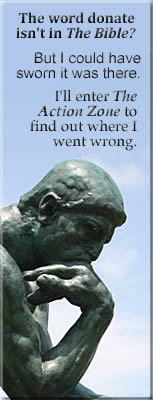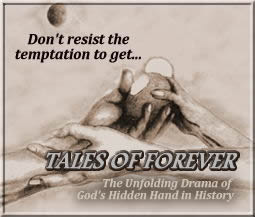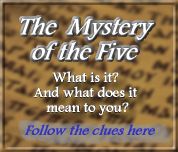Patterns in Time
Cataloging the Events of History
In Satan’s endless attempts to thwart God’s rescue efforts, there is the recurring theme of the sacrifice of the innocents in the drama of redeeming God’s people, beginning with the slaughter of the first lambs, which were slain to provide sheepskins to cover Adam and Eve.1
The same thing happened again when an innocent child was brutally murdered by Nimrod, who thought he was killing the young Abraham.2
And again these same events echoed in time with regard to the circumstances surrounding the infamous slaughter of the innocents at the births of both Moses and Jesus.3
Fortunately, similar patterns are exhibited in regard to the deliverance of God’s people as well. To start with, there is a pattern of similar celestial events which seem to mark pivotal points in biblical history. But, because of the undue treatment which most apocryphal literature has received, most people are much less aware that at the birth of Abraham, another celestial event alerted the king of that day: Nimrod. According to The Book of Jasher, a huge star was seen devouring four other stars from each direction in the night sky. The sorcerers and sages correctly interpreted the event as the beginning of the end of Nimrod’s kingdom. They warned the king that the child born that night would overthrow them all. Fearful of the prophecy, Nimrod also set out to kill the child of destiny.4
Even less well known is the fact that, according to The First Book of Adam and Eve, at the creation of Adam, God appointed four special stars for him, one for each cardinal point of the world.5
Symbolic of the dominion God had granted to Adam, these stars, I believe are the same stars which Nimrod’s sorcerers, as recorded in Jasher, would then see being gobbled up on the night of Abraham’s birth.6
Story Continues Below
To hear Kent, Zen Garcia and S. Douglas Woodward, as they discuss the 5,500-year chronology from Adam to Christ, from the perspective of The Septuagint Bible, to confirm the contents of Tales of Forever, CLICK BELOW.
Story Continues From Above
Having lost his original dominion to Satan and rebels like Nimrod, Adam’s final destiny would lay in the fate of this helpless son of Terah. Now it was being revealed that, through the child, Abraham, the control of Earth was about to begin reverting back to the descendants of Adam. That’s why Satan would try, again and again, to destroy Abraham, using whatever means he had at his disposal, trying desperately to prevent him from toppling Nimrod’s kingdom and thus, begin to fulfill God’s promise of rescuing the descendants of Adam.7
Further similarities between Abraham and Moses provide additional evidence of the types and shadows that all point to Christ. Another proof of the hidden Christ, eventually revealing its meaning in due time, is the deliverance of Isaac, when Abraham agrees to sacrifice him on Mount Moriah.8
It seems as if nearly everything Abraham did laid a prophetic foundation for the future of his ancestors, for good as well as for bad. Even his vain attempts to protect his wife, as they traveled through foreign countries, are later repeated by his son Isaac as he tries to cover up the fact that he and Rebecca are married.9
And Jacob also lies and connives his way through life, forever trying to help God fulfill His promises, just like his grandfather. Satan even appeared in the courts of Heaven to complain to God about Abraham, just as he would later accuse Job.10
Similarly, the young Abraham was thrown into Nimrod’s furnace, and miraculously he survived for three full days.11
Clearly, this, too, is a type of events which would later be described in the biblical record. In The Book of Daniel, three Hebrews by the name of Shadrach, Meshech, and Abednego, would also survive in a fiery furnace. These, of course, were both just shadows of things to come, leading us to a greater awareness of when, according to The Lost Books of the Bible, Christ would descend into Hades for three days and nights.12
And, as Abraham and the three Hebrews would be protected, so also the Christ was to come forth, unharmed, as proof of God’s promise to Adam and Eve that He would, in fact, rescue them through His own death and resurrection.13
Throughout this drama of the ages, a primordial cave reoccurs again and again: First, God ordered Adam and Eve to live in a cave, and to establish a home there. It was called The Cave of Treasures.14
To survive the threat of Nimrod and his sorcerers, Abraham and his mother were forced to seek refuge in a cave, where young Abraham was nurtured for many years.15
The three days and nights when Christ descended into Hades to rescue Adam’s descendants corresponds with a giant rock that Satan tried to crush Adam with.16
To protect Adam and Eve, God turned the rock into a cave to shelter them; but to teach them a lesson, they were imprisoned there for a full three days before they were released.17
So, maybe there really is a logic to these legends, after all. It’s time to discover the truth for yourself. Begin the journey today, with Tales of Forever.






